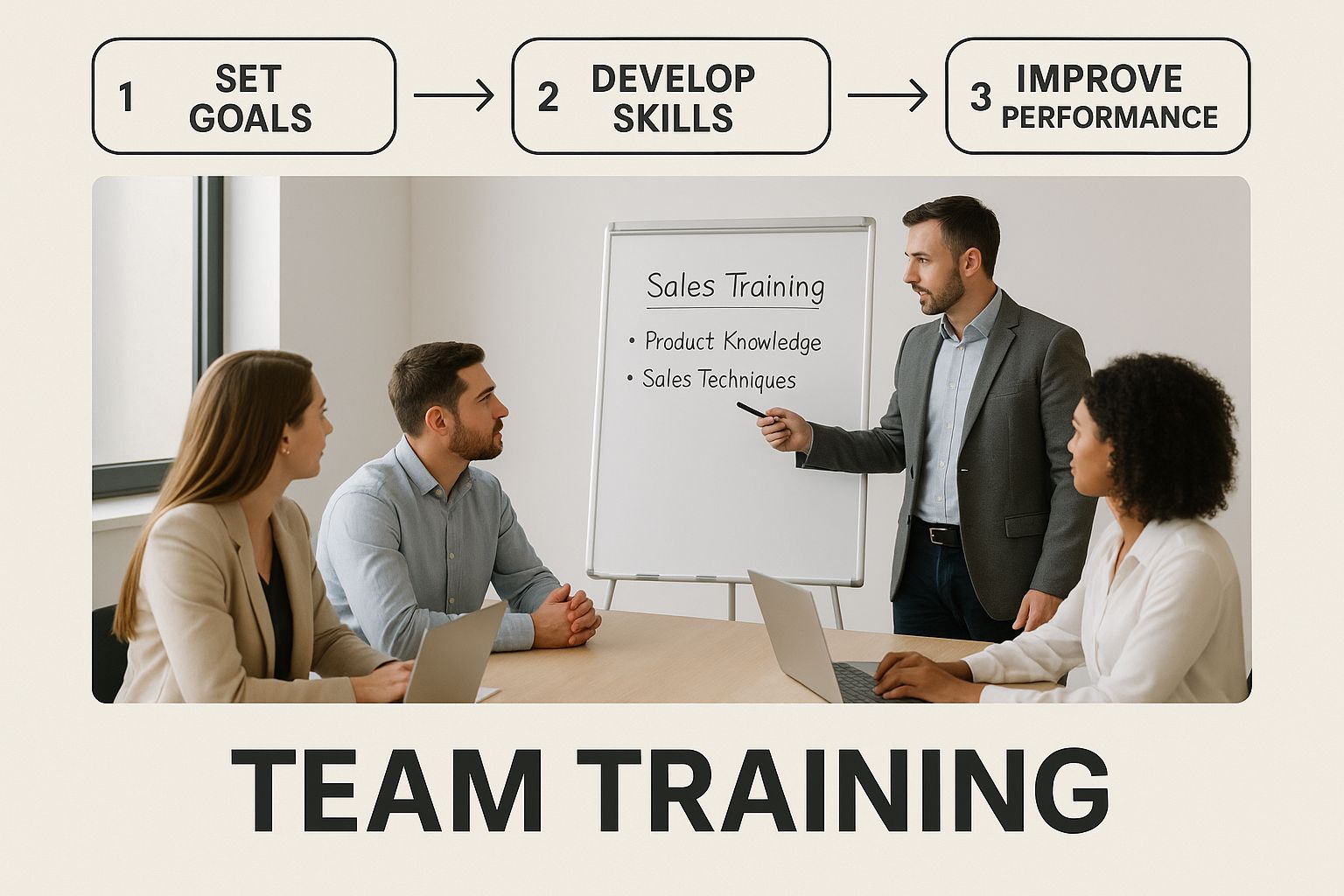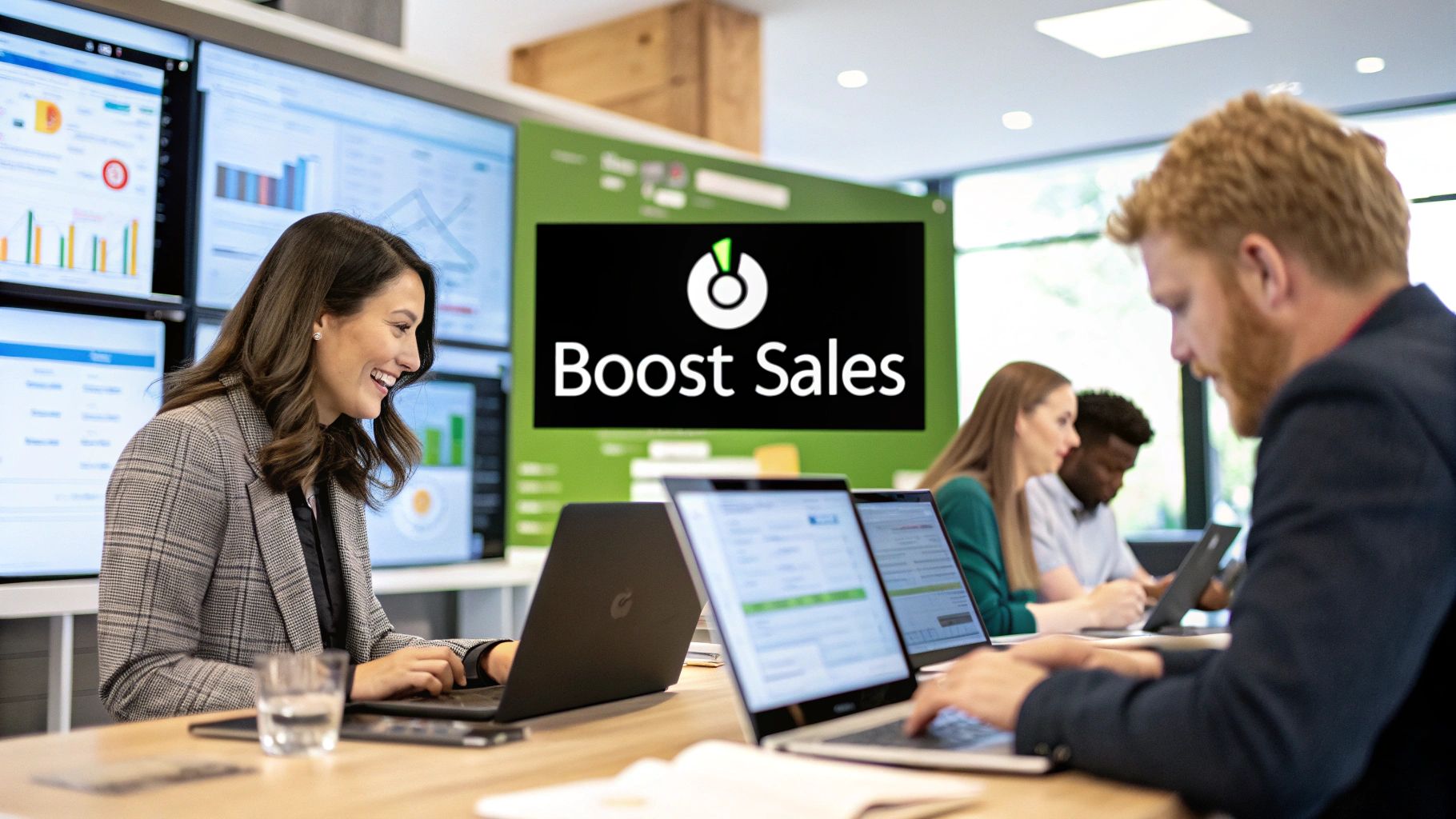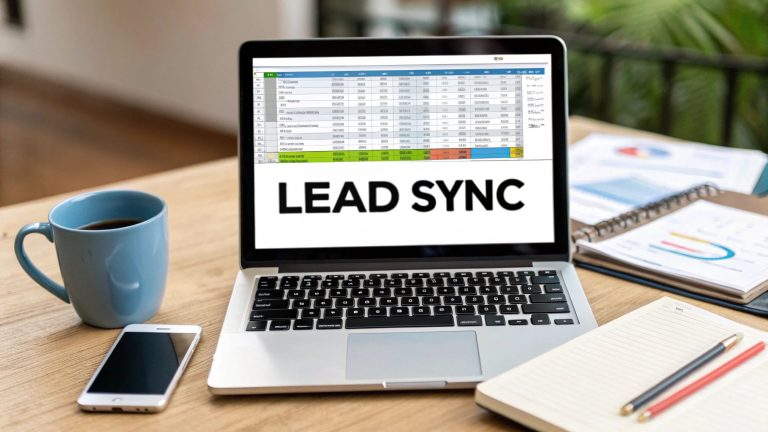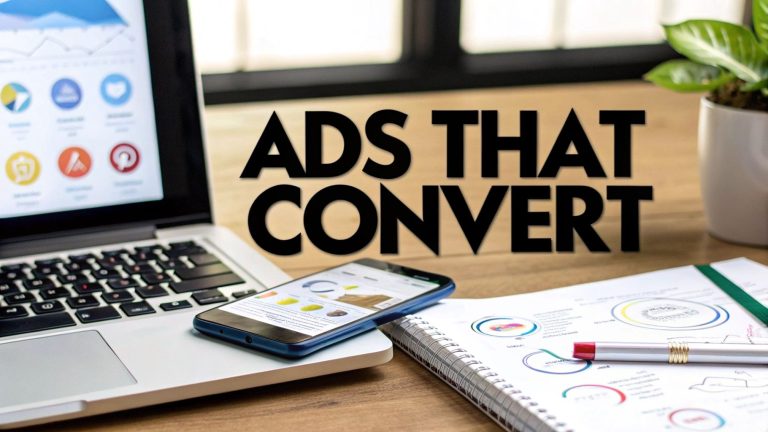How to Increase Sales Performance for Modern Teams
Trying to increase sales performance often feels like you’re being told to just "work harder." But the truth is, it’s not about putting in more hours—it’s about working smarter.
Real, sustainable growth comes from mastering three core areas: nailing your lead response time, building a sales pipeline you can actually trust, and using smart automation to your advantage. This guide is your modern playbook for doing exactly that.
A Modern Blueprint for Sales Excellence

In a market this competitive, simply grinding away doesn't guarantee better results. I've seen countless sales teams follow all the traditional advice and still fall short of their goals. The numbers back this up—a staggering 91% of sales leaders didn't hit their quota expectations last year. This isn't a sign to push harder; it's a signal to get smarter.
The blueprint for boosting sales performance isn't about vague platitudes. It's about building a system that drives predictable growth. This means creating a seamless process that captures and nurtures every single lead, managing your sales pipeline with laser-like precision, and using technology to amplify what your team does best.
To help you get started, we've summarized the key pillars of a high-performing sales strategy and what you can expect from them.
Pillars of High-Performing Sales Teams
| Strategy Pillar | Key Action | Expected Outcome |
|---|---|---|
| Systematic Lead Engagement | Automate initial touchpoints to ensure rapid, personal follow-up. | Higher lead conversion rates and improved customer trust from day one. |
| Pipeline Integrity | Define clear, non-negotiable criteria for each stage of your sales pipeline. | More accurate sales forecasting and the ability to spot and fix bottlenecks early. |
| Strategic Automation | Use tools like LeadSavvy Pro to handle repetitive, low-value administrative tasks. | Frees up your sales reps to focus on what matters: building relationships and closing deals. |
These pillars work together to create a powerful, self-sustaining system for growth.
The Core of a Modern Sales Strategy
To really dig in, it's crucial to understand the expert tips and strategies on how to improve sales team performance. The most effective approaches are always built on continuous improvement and a real understanding of what actually moves the needle.
The foundation of this blueprint includes:
- Systematic Lead Engagement: This goes way beyond just "follow up fast." It's about creating automated yet personal touchpoints that build trust from the very first interaction.
- Pipeline Integrity: You need to establish crystal-clear criteria for each stage in your pipeline. This is the only way to get accurate forecasts and spot bottlenecks before they completely derail your targets.
- Strategic Automation: This is where tools like LeadSavvy Pro become your secret weapon. By automating repetitive tasks, you free up your team to focus on high-value activities like building relationships and closing deals.
I've found that the biggest indicator of sales performance often boils down to one thing: how much time reps spend directly engaging with buyers. The top performers always dedicate more of their day to these interactions, and it makes all the difference.
This approach transforms your sales operation from a collection of individual efforts into a cohesive, high-functioning engine. While individual talent is obviously important, lasting success comes from a well-defined process that everyone follows. For a deeper dive, check out our other guide on how to boost sales team performance with systematic changes.
By focusing on these core pillars, you're not just chasing a number—you're building a framework for stronger customer relationships and sustainable revenue growth.
Mastering Your Lead Response and Nurturing Game
In sales, speed isn't just a suggestion; it's your secret weapon. Responding to a lead within the first five minutes can boost your odds of connecting by a staggering 100x. But speed alone won't close deals. A generic, robotic follow-up is almost as bad as no follow-up at all. That first interaction sets the tone for everything that follows.
This is where you need a rock-solid process for engaging leads instantly and with real value. The goal is to turn a cold inquiry into a warm conversation without being pushy or annoying.
The single biggest roadblock I see for sales teams is the time they burn on non-selling tasks. Reps spend nearly 28% of their week on administrative work. A smart lead response system automates the grunt work, giving that precious time back to your team.
Think about a B2B software company. The second someone requests a demo, the clock is ticking. A top-performing team doesn’t just get an email notification; they have an automated system that fires on all cylinders.
- Within 1 minute: An automated but personalized email lands in their inbox. It confirms the request, offers a few booking slots, and includes a link to a relevant case study.
- Within 5-10 minutes: The assigned sales rep gets a push notification with all the lead's details—company size, specific interests, you name it.
- Within 1 hour: The rep makes a quick, friendly phone call. This isn't a hard pitch. It's a simple "Hey, saw you requested a demo, wanted to introduce myself and make sure you got everything you need."
This multi-channel blitz feels personal and attentive, not automated. It shows you're on the ball and respect their time, building a foundation of trust from day one.
Structuring Your Nurturing Sequences
One touchpoint is never enough. It takes, on average, more than 12 attempts to actually engage a potential buyer. That's why a structured, multi-channel nurturing sequence is non-negotiable. Your goal is to educate and build trust, not just hammer them with meeting requests.
Here’s what a balanced sequence could look like:
- Day 1 (Instant): Automated personalized email + manual phone call.
- Day 2: LinkedIn connection request with a short, personalized note mentioning their demo request.
- Day 4: A follow-up email sharing a different piece of value, like a blog post or a quick video tip addressing a common pain point.
- Day 7: Another phone call, but this time with a specific insight or question about their needs.
- Day 10: A final "breakup" email. Gently offer to close their file but leave the door open for the future.
Every single touchpoint has to provide value. Teach them something, offer a resource, or share an insight. This is how you stay top-of-mind without becoming a pest.
Personalizing at Scale Without Sounding Robotic
Let's be real, everyone's scared of automation sounding, well, robotic. The trick is to use automation for speed and data for personalization.
Instead of a bland "Thanks for your interest," use the info from their lead form. If a lead from the e-commerce industry signs up, your automated email could dynamically add a line like, "I saw you're in e-commerce. Our clients in your industry often see a 20% uplift in conversions with our solution."
That small touch shows you’re paying attention.
For your reps, tools like LeadSavvy Pro are a game-changer. It pushes all the lead data directly into their workflow, so they aren't wasting time digging for info. They can just focus on crafting a message that hits home.
Of course, knowing how to write cold emails that get replies is crucial here, since the same principles of value-first personalization apply to warming up inbound leads.
You also need to prioritize who gets this high-touch treatment. That's what lead scoring is for. By assigning points based on who they are and what they do, you focus your team's energy where it counts most. You can dive into different lead scoring examples in our detailed guide to build a model that works for you.
By combining speed, a structured follow-up plan, and smart personalization, you build a nurturing machine that ensures no lead ever falls through the cracks. It's a cornerstone for increasing sales performance in any business.
Building an Unbeatable Sales Pipeline
Let's be honest: a sales pipeline is the true heartbeat of any successful sales team. It’s so much more than a list of potential deals. A well-built pipeline is a living system that gives you clarity, predictability, and a genuine roadmap for growth.
If you’re flying blind without one, you’re just reacting to deals as they come, not orchestrating them.
Learning how to increase sales performance starts here. Building an unbeatable pipeline turns your sales efforts from a bunch of hopeful chats into a structured, measurable journey. Every stage has a purpose, every deal has a clear next step, and your team knows exactly what it takes to move a prospect from one stage to the next.
This structure also solves one of the biggest sales killers: a pipeline clogged with "hopeful" but dead-in-the-water deals.
Defining Your Pipeline Stages
First things first, you need to establish clear, non-negotiable stages that actually mirror your customer's buying journey. While this will look different depending on your industry, a classic B2B pipeline usually includes something like this:
- Prospecting: Finding potential customers who match your ideal customer profile.
- Qualification: The first real touchpoint where you confirm the prospect has a genuine need, the budget, and the authority to buy (think BANT, MEDDIC, or a similar framework).
- Meeting/Demo: A scheduled discovery call or product demo where you get to dive deep into their specific challenges.
- Proposal/Quote Sent: You’ve laid out a tailored solution and sent over a formal proposal with all the numbers.
- Negotiation: This is where you hash out the terms, handle any last-minute objections, and get all the key players to sign off.
- Closed Won/Lost: The final result.
For every single stage, you have to define strict exit criteria. What must a prospect do to move from Qualification to Meeting? For example, maybe they have to explicitly confirm a budget range and tell you who the final decision-maker is. Without these rules, reps will inevitably push deals forward based on pure optimism, leading to a messy pipeline and wildly inaccurate forecasts.
I see this all the time—deals just sitting in one stage for weeks with no clear next steps. A healthy pipeline has constant motion. If a deal hasn't moved in 30 days, it’s not a 'slow burn.' It's a bottleneck that needs your immediate attention.
Spotting and Clearing Bottlenecks
This is where a visual sales pipeline dashboard becomes your best friend. When you see deals piling up in one particular stage, you’ve just found a bottleneck.
Think about a sales manager, Sarah. She notices her team's deals are consistently getting stuck after the "Proposal/Quote Sent" stage. Her team is great at giving demos, but then… radio silence. Instead of just barking "follow up more!" at her team, she uses this data as a coaching opportunity.
She digs in and finds out her reps are sending out generic, one-size-fits-all proposals. They aren't reminding the prospect of their specific pain points or clearly spelling out the ROI. That's a huge insight into their sales performance.
Fixing these kinds of bottlenecks with targeted team training is how you build a smoother, more effective process.

The image above nails it: targeted coaching around a specific pipeline weakness, like proposal writing, directly improves a team's ability to close. The real takeaway is that data-driven coaching is infinitely more powerful than generic advice.
The Non-Negotiable Hub for Pipeline Data
To manage all this without losing your mind, you need a central source of truth. Tracking deals in spreadsheets is a recipe for disaster—it leads to stale data, missed follow-ups, and zero visibility for anyone. This is where a Customer Relationship Management (CRM) system becomes absolutely essential.
A CRM is the non-negotiable hub for every bit of pipeline data and sales activity. It tracks every interaction, sends automated reminders, and gives you the visual dashboards you need to monitor deal flow.
The impact is massive. Adopting a CRM is one of the most effective ways to increase sales performance. In fact, 94% of businesses report a boost in sales productivity after getting one. Companies using a CRM have seen sales increase by up to 29%, productivity jump by 34%, and forecast accuracy improve by a staggering 42%. You can discover more about these powerful sales statistics and how to use them to guide your own strategy.
With a tool like LeadSavvy Pro, you can take it a step further. New leads from your Facebook campaigns can be piped directly into your CRM or a connected Google Sheet, ensuring every single opportunity enters your pipeline instantly. This completely eliminates manual data entry and lets your team engage with prospects while they're still hot, kicking off the pipeline journey on the strongest possible foot.
Using Smart Automation and AI to Amplify Sales
If you really want to move the needle on sales performance, you have to give your reps their most valuable resource back: time. This is where automation and AI stop being industry buzzwords and start becoming your team's most powerful allies.
The goal isn't to replace your talented salespeople. It's to supercharge them. You do that by taking the tedious, low-value tasks off their plate—the stuff that drains their energy and kills their focus.
Think about the daily grind. Your reps are burning hours on manual data entry, bouncing between a dozen websites to research a single prospect, and playing email tag just to get a meeting on the calendar. Every minute they spend on that admin is a minute they aren't spending building relationships, understanding what a customer actually needs, or closing deals.
AI in sales is quickly becoming the new standard. In fact, 35% of Chief Revenue Officers are already building dedicated AI teams to weave this tech into their core strategy. That's a huge shift, and it’s happening for one simple reason: AI frees up your people to do the high-impact, human stuff. You can read more about how AI is reshaping sales trends and see why it's such a key driver for growth.
Take the administrative work off their shoulders, and you empower your team to operate at their absolute best.
Automating the Grunt Work
The easiest and most immediate win you'll get from automation is wiping out all those repetitive tasks. These are the necessary evils of sales—the things that have to get done but bog down even your most efficient reps. Smart tools can handle this work behind the scenes, freeing up your team to focus on what actually brings in revenue.
Here are the first things you should look to automate:
- Lead Data Entry: A new lead from a Facebook ad comes in. Someone has to stop what they're doing, copy the info, and paste it into your CRM. It's slow, and mistakes happen. A tool like LeadSavvy Pro can pipe those leads directly into your system, instantly. No more copy-paste.
- Initial Lead Research: Before a rep can make a truly personal call, they need context. AI can scan a prospect’s LinkedIn, company website, and recent news to pull out key talking points in seconds. This turns an hour of digging into a few minutes of review.
- Meeting Scheduling: The endless back-and-forth of "Does Tuesday at 2 work?" is a massive time-waster. Scheduling tools that sync with your calendar let prospects book a time that works for them with a single click. It's a game-changer.
I once worked with a rep, Maria, who spent her first hour every single day just compiling lead lists and researching her top five prospects. We set her up with a tool that automatically prepped a "daily briefing" for her, complete with key insights for every person on her call list. Just like that, she got an hour back every day to focus purely on selling.
This isn't about some far-off futuristic idea. These are practical tools that solve real problems today. By taking these mundane tasks off their plate, you directly help your team hit their numbers.
Crafting Hyper-Personalized Outreach at Scale
Everyone knows personalization is the key to breaking through the noise. But doing it right is incredibly time-consuming, especially when you have hundreds of leads. This is exactly where AI shines, helping your team create highly relevant messages without slowing them down.
Let's walk through a classic scenario. A rep needs to follow up with a prospect who downloaded an eBook on supply chain management.
- The Old Way: The rep sends a generic email. "Hi John, thanks for downloading our eBook. Let me know if you want to chat." It's easy, but it’s just as easy to ignore. It has no substance.
- The AI-Powered Way: An AI tool flags that John recently posted on LinkedIn about challenges with international shipping delays. Armed with that insight, the rep sends a much stronger message: "Hi John, I saw your post about shipping delays—it's a massive challenge right now. Chapter 3 of that eBook has a specific framework for mitigating those risks that I think you'll find valuable."
Which email do you think gets a reply? The second one, every time. It proves the rep did their homework and is offering immediate, relevant value. AI makes this level of personalization possible for all your leads, not just the handful you have time for.
Prioritizing Your Best Opportunities with AI
Let's be honest: not all leads are created equal. A huge part of boosting sales performance is making sure your team spends their time on prospects who are actually likely to buy. AI-powered lead scoring is the perfect tool for this.
Instead of just looking at basic demographic data, AI can analyze a whole range of buying signals in real-time:
- Website Behavior: Did the prospect visit your pricing page three times this week?
- Content Engagement: Have they downloaded multiple whitepapers on the same topic?
- Email Interaction: Are they consistently opening your newsletters and clicking the links?
AI takes all of these data points and assigns a dynamic score to every lead, telling your sales team exactly who to call first. This ensures your team's most precious asset—their time—is always aimed at the opportunities with the highest chance of closing. That’s how you build a smarter, more effective sales process from the ground up.
Tracking the Sales Metrics That Actually Matter

You can't improve what you don't measure. It’s an old saying, but it’s the absolute foundation for anyone serious about figuring out how to increase sales performance. The problem is, it’s easy to drown in a sea of data, obsessing over "vanity metrics" that look good on a chart but don’t actually help you sell more.
The real key is focusing on the few key performance indicators (KPIs) that act as a true diagnostic tool for your entire sales engine.
This isn't just theory. When you learn that a staggering 84% of sales reps recently missed their quotas, it’s a clear signal that something is broken. Top-performing teams get ahead by looking past the final revenue number. They track a focused set of metrics that tell the whole story—from pipeline health to team activities and, finally, business outcomes.
Instead of seeing a missed quota as a failure, you need to see it as a data point. It’s a signal that something in your process needs a tune-up. By digging into the right metrics, you can pinpoint the exact source of the problem and fix it.
Moving Beyond Vanity Metrics
It's tempting to pat yourself on the back for a high number of calls made or emails sent. But activity for activity’s sake is a waste of time. What good are 100 cold calls if none of them turn into conversations?
True performance metrics give you a clear, honest picture of your sales process's health, from the first touch to the final signature.
This means shifting your focus from, "How much did we do?" to, "How effective were our actions?" Let's break down the metrics that truly move the needle into three core areas:
- Pipeline Health Metrics: These tell you about the flow and efficiency of your sales process.
- Sales Activity Metrics: These measure the quality and impact of your team's day-to-day efforts.
- Business Outcome Metrics: These are the bottom-line numbers that reflect overall success.
By keeping an eye on all three, you get a balanced view of performance and can stop guessing what’s wrong and start knowing.
Pipeline Health: Your Diagnostic Dashboard
Think of your sales pipeline as a living system. These metrics are its vital signs, helping you spot bottlenecks before they become disasters and forecast with much greater accuracy.
Here’s a classic example: A sales manager notices her team’s lead-to-opportunity conversion rate is way below the 30% industry benchmark. Instead of just telling everyone to "qualify better," she uses that data to investigate. She discovers her SDRs are having a tough time explaining the product's value on initial calls.
Armed with that insight, she can run targeted coaching sessions on the discovery process, directly fixing the leak at the top of the funnel.
Your pipeline data is your most honest consultant. A low conversion rate between two stages isn't a failure—it's a bright, flashing arrow pointing directly to where your team needs coaching the most. Use it as a guide, not a report card.
Here are the pipeline metrics you absolutely must have on your dashboard:
- Conversion Rate by Stage: What percentage of deals move from one stage to the next? A big drop-off anywhere is a clear red flag that something’s broken in that specific step.
- Sales Cycle Length: On average, how long does it take to close a deal? If this number starts creeping up, you might have a process issue or be facing new buyer objections.
- Pipeline Velocity: How fast are deals moving through your pipeline? This is a powerful indicator of your sales engine's overall health and efficiency.
Tracking Activities That Drive Real Engagement
Not all sales activities are created equal. One hundred generic, templated emails are far less valuable than five meaningful conversations with qualified prospects. The goal isn't to track busywork; it's to track the actions that genuinely move deals forward.
So, instead of just counting calls, start tracking meaningful conversations—discussions where needs are uncovered and a clear next step is agreed upon. Instead of counting emails sent, track meetings booked from your outreach. That’s a direct measure of your team's ability to spark real interest.
Often, improving these numbers comes down to giving your reps the right tools and support. To dig deeper, check out our guide on how to improve sales productivity with the right tools and strategies for some practical tips.
Measuring the Ultimate Business Outcomes
Finally, we get to the metrics that tie directly to revenue and growth. These are the results of all your hard work in pipeline management and sales activities. They are the ultimate proof of whether your strategy is working.
| Outcome Metric | Why It Matters | What It Tells You |
|---|---|---|
| Quota Attainment | The ultimate measure of a rep's and team's success in hitting their targets. | Shows the overall effectiveness of your sales strategy and team execution. |
| Average Deal Size | The average revenue generated per closed deal. | Helps with forecasting and can indicate success in upselling or cross-selling. |
| Customer Acquisition Cost (CAC) | The total sales and marketing cost to acquire one new customer. | Reveals the efficiency and profitability of your customer acquisition engine. |
When you track these outcome metrics, you can see the direct financial impact of the improvements you’re making higher up in the funnel. They provide the final word on whether your strategies to boost sales performance are truly paying off.
Answering Your Top Sales Performance Questions
Whenever you roll out a new strategy, the team will have questions. It's only natural. As you work to boost your sales performance, you’ll start wondering about timelines, what to tackle first, and how to handle the human side of all this change. Let's dig into some of the most common hurdles I see sales leaders and reps run into.
These aren't just hypotheticals—they're the real-world obstacles that can make or break a new initiative. Getting clear on the answers will give your team the confidence they need to actually use the new systems you’re putting in place.
How Long Until a New CRM Actually Shows Results?
This is the big one, right? The honest, no-fluff answer is: it all comes down to how quickly your team starts using it. A CRM isn't a magic wand; its value is directly tied to consistent, daily use.
You can start to feel some of the initial perks—like cleaner data and fewer missed follow-ups—within the first 30 days.
But the real game-changing stuff, like accurate sales forecasting and spotting where your pipeline is leaking? That usually takes a full quarter (90 days) to really take shape. You need that much data to see the patterns that matter.
The secret is to go for quick wins. Get your team trained on just one or two core features first, like logging calls and managing contacts. Once that becomes second nature, then you can introduce the fancy reporting dashboards.
What’s the First Thing I Should Automate?
For most small businesses, the best place to start is with the task that wastes the most time. Nine times out of ten, that's automated lead capture and notification.
Think about it. Manually downloading leads from places like Facebook Lead Ads is painfully slow and full of opportunities for mistakes. By the time a rep finally gets that lead's info, they’ve already moved on.
- The Problem: Reps are stuck doing admin work instead of what they do best—selling.
- The Fix: Use a tool like LeadSavvy Pro to instantly push new leads into a Google Sheet or your CRM.
- The Result: Your team gets a notification in real-time and can follow up within minutes. That speed dramatically boosts the odds they'll actually connect with and convert the lead.
How Do I Coach with Data Without Being a Micromanager?
Using performance data to coach your team is a delicate dance. You want to empower your reps, not make them feel like Big Brother is watching their every move. The key is to change the conversation from judgment to diagnosis.
Instead of saying, "Your conversion rate is too low," try framing it differently. "Hey, I noticed a bunch of our deals are stalling out after the demo. Let's brainstorm some ways we can show more value in our proposals."
See the difference? It frames the data as a shared problem you can solve together. That's how you build trust and get everyone pulling in the same direction.
Ready to stop wasting time on manual lead entry and get your team responding instantly? LeadSavvy Pro automates your lead capture from Facebook, sending new prospects straight into your workflow. You can focus on what really matters—closing deals. Start for free with LeadSavvy Pro today.







